Why you can trust Tom's Hardware
For our power, temperature, clock speed, and fan speed testing, we use Powenetics hardware and software. We capture in-line GPU power consumption by collecting data while looping Metro Exodus — at 1440p ultra with midrange and higher GPUs. We also test with the FurMark stress test at 1600x900. Our power testing PC uses an open testbed, as that's required for all the extra wires and riser card, and it's the same Core i9-9900K that we've used for the past several years.
As noted earlier, we had to install a second graphics card in the PC to get the A770 to POST, but we disabled the card in Device Manager and our equipment doesn't include the power use from the other PCIe slot. GPU-Z meanwhile monitors the fan speeds, clock speeds, and other aspects of the cards, though it doesn't capture fan speed as a percentage. The GPU core clocks and fan speeds also seen to be getting slightly erratic readings — or perhaps they just expose far more granular data that causes some jitter in the charts.
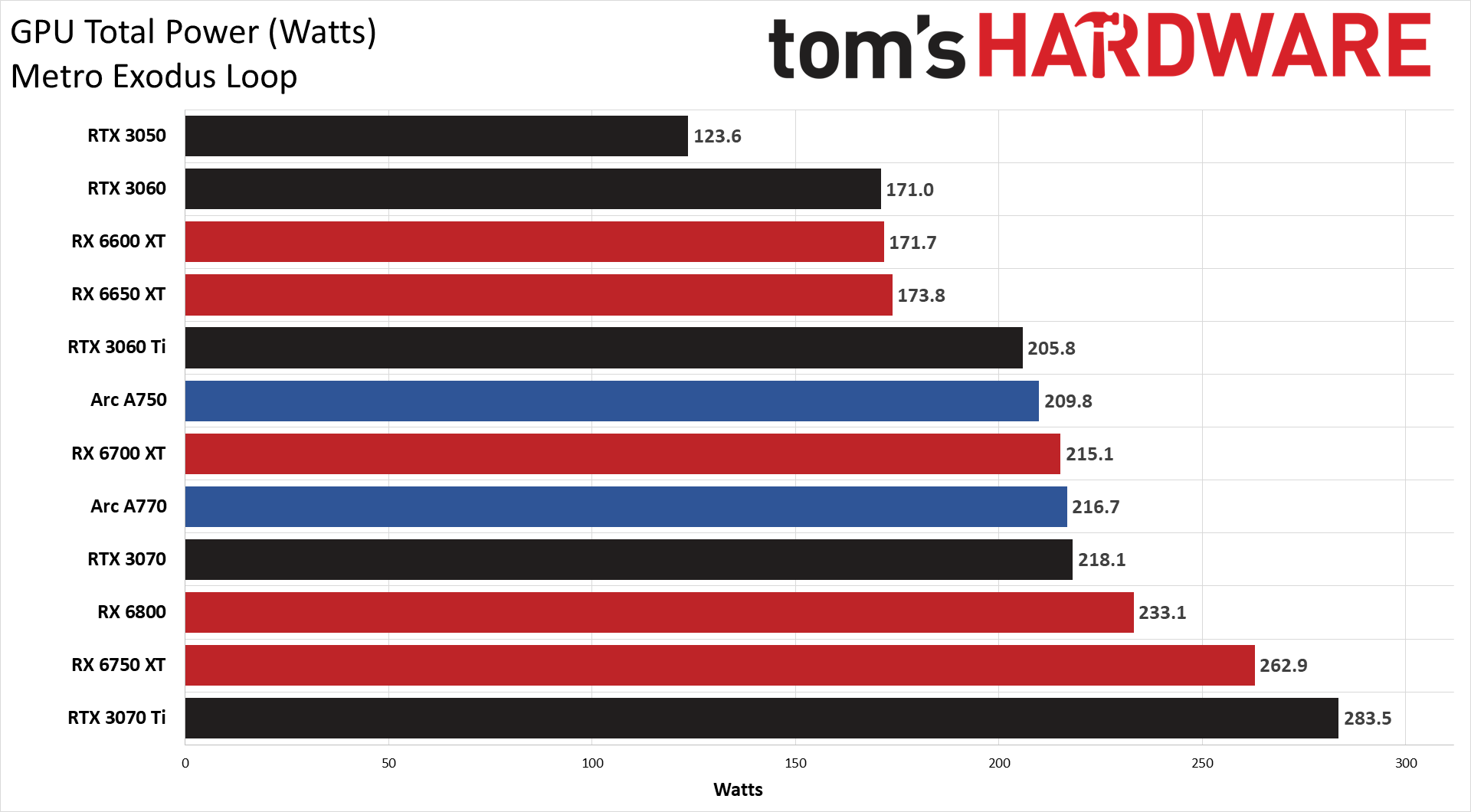
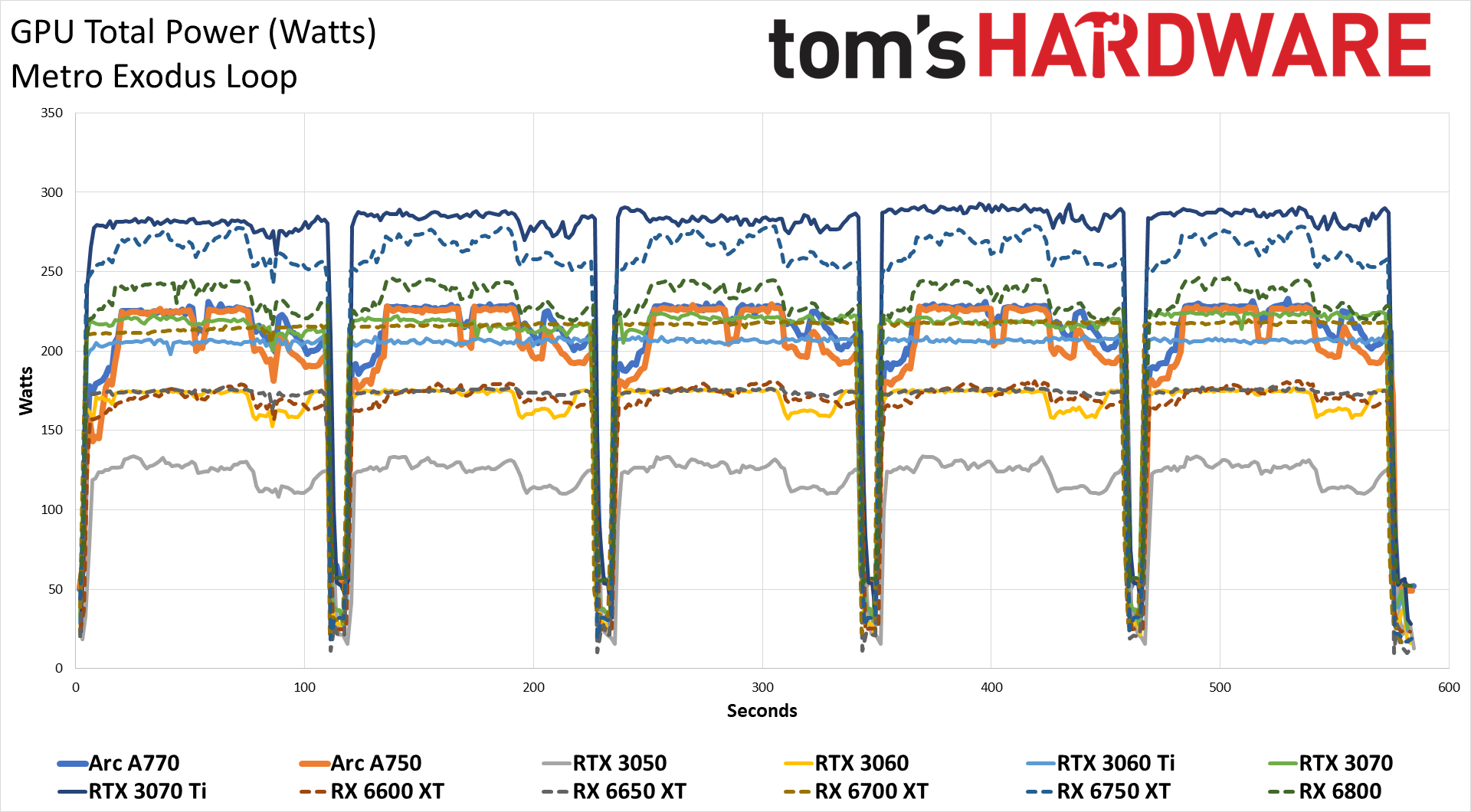



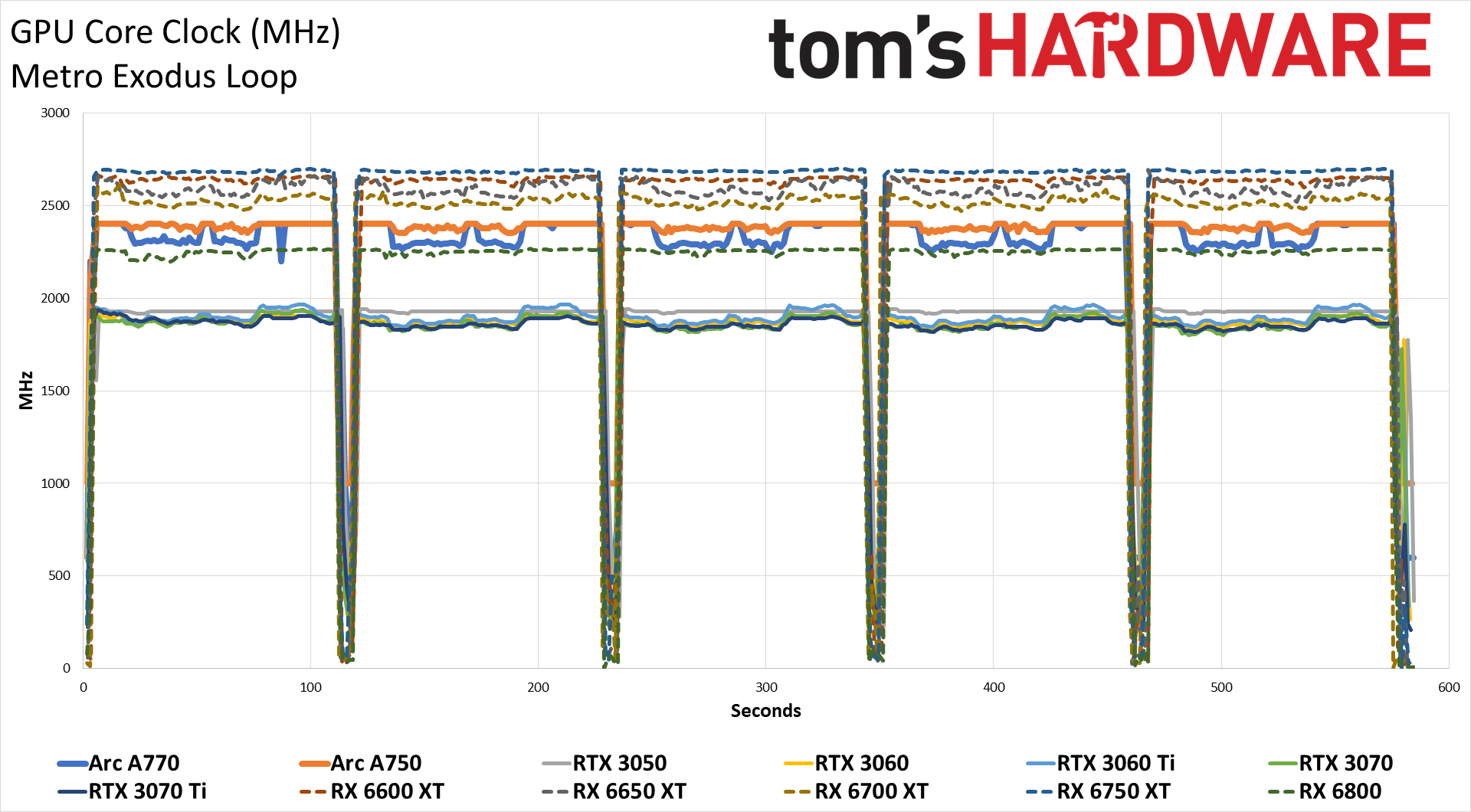








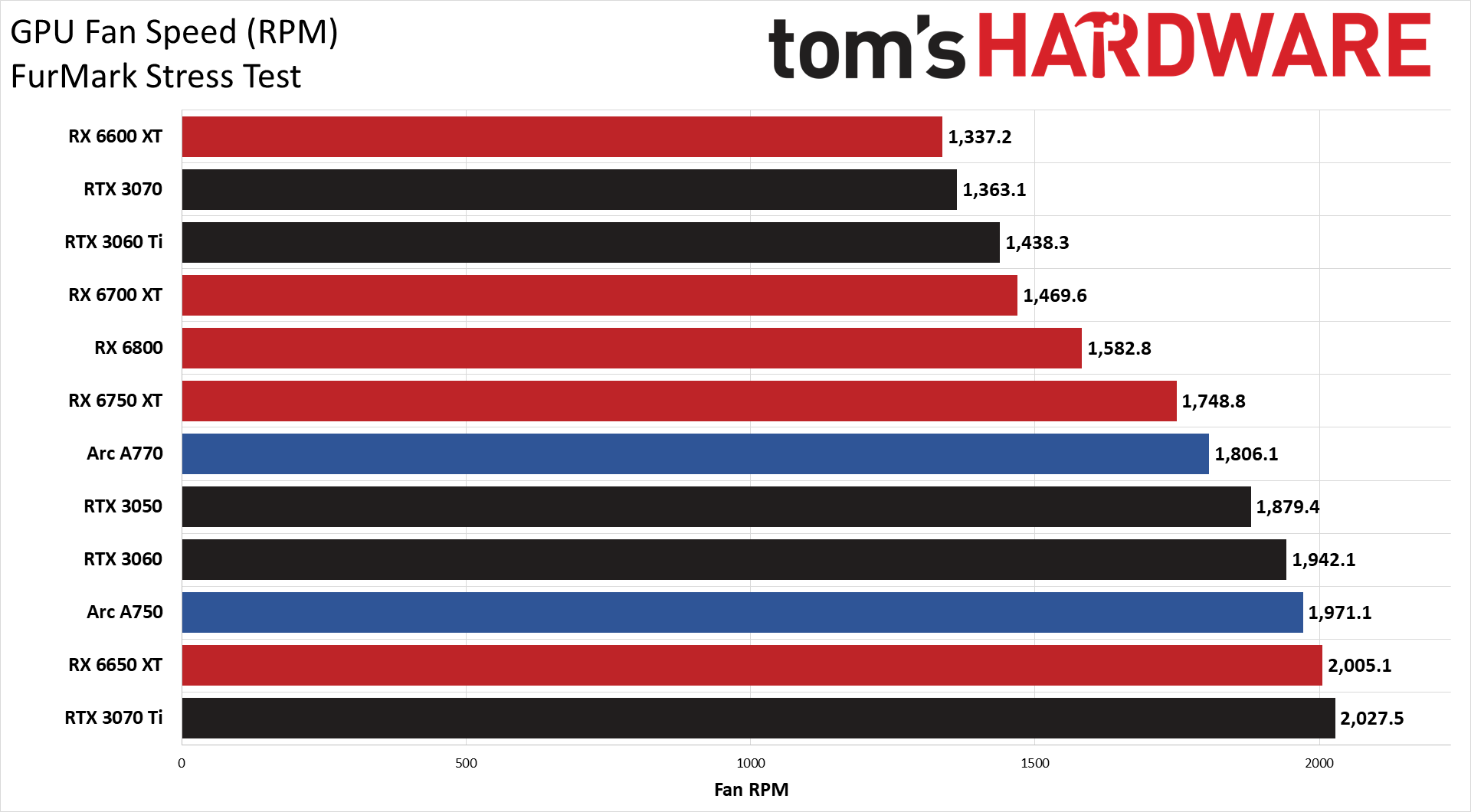
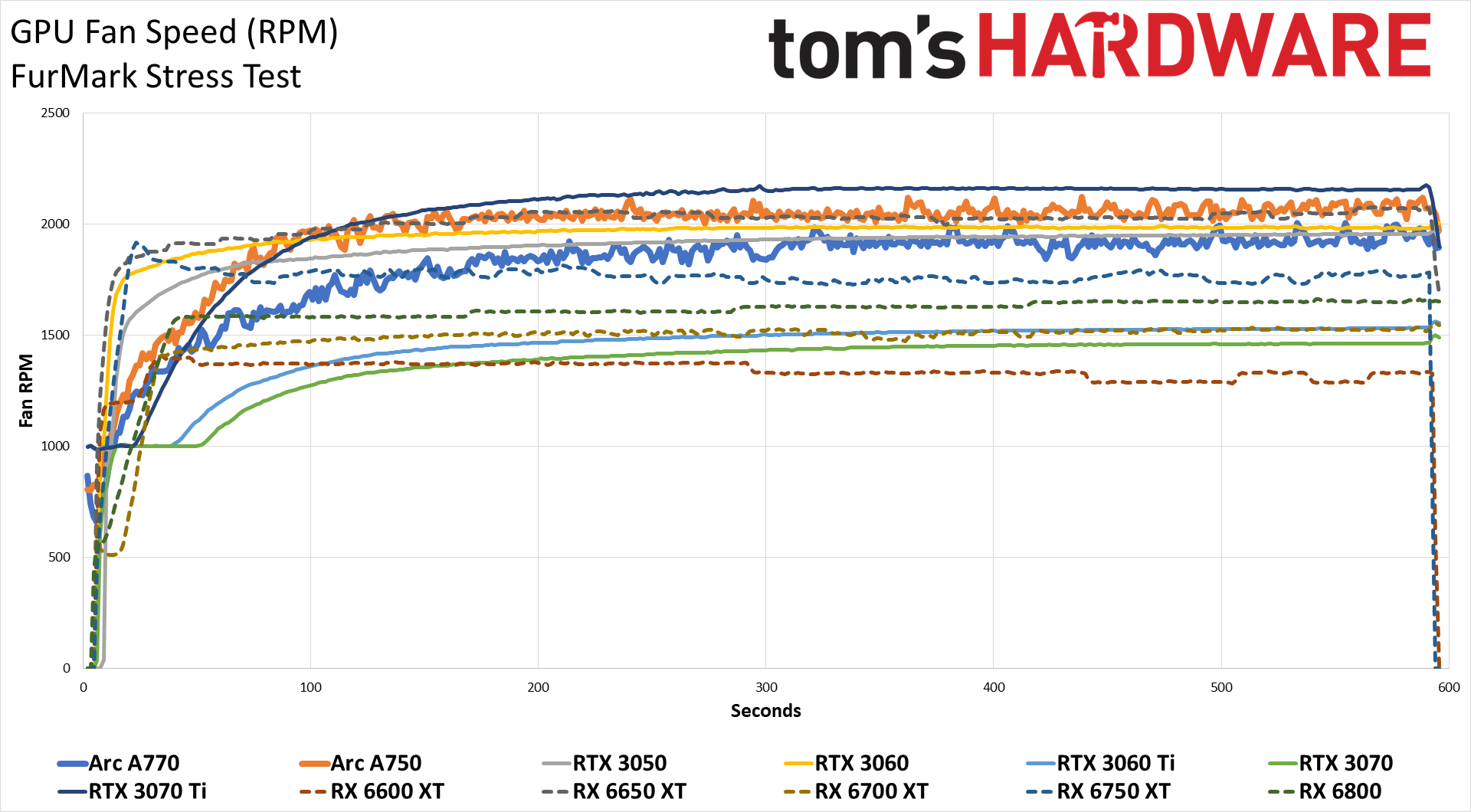
For the A770 Limited Edition, average power use while running Metro Exodus was 217W, though peak power spiked as high as 253W. The 8-pin connector maxed out at 146W, the 6-pin at 63W, and the PCIe slot at 48W, so all of the connectors are within spec. While the GPU was under load during the Metro benchmark, power use ranged between 190W and 230W.
As usual, FurMark generated a far more consistent load, and the A770 LE stayed very close to its 225W TBP, averaging 223W during our test. It's interesting that the A750 LE actually consumed more power, indicating the silicon binning is quite real. The A770 can likely maintain lower voltages while running at higher clocks.
While we don't normally discuss idle power use, mostly because it's not much of a concern with modern GPUs, the Arc cards do warrant an extra footnote. Power use at idle with the Arc A770 LE was significantly higher than on competing GPUs. With our Powenetics hardware, we recorded average power draw over 30 seconds of 48.1W. The RTX 3060 meanwhile averaged 15.0W while the RX 6650 XT used just 7.3W. Intel says it's aware of the problem and is working on a potential fix.
While Intel advertises a 2100 MHz typical game clock, our experience suggests the cards will do far more than that on a consistent basis. For example, the A770 averaged 2350 MHz in the Metro test, but more importantly, it also managed to run at 2375 MHz during FurMark's stress test. Considering FurMark often represents something of a worst-case scenario, the fact that the GPU clocked well above Intel's official speed means you'll likely get better performance.
Fan speeds appear to be tuned for peak temperatures of around 75C, at least for our test environment. We saw a maximum temperature of 75C on the A770 in both tests, with peak fan speeds of 2032 RPM in Metro and 2041 RPM in FurMark. Average fan speeds were quite a bit lower, with 1763 RPM in Metro and 1806 RPM in FurMark.
For noise testing, we positioned the SPL (sound pressure level) meter between the two fans at a distance of about 10cm to minimize the impact of the CPU cooling fans — and we ensured the secondary card's fans were stopped. We had a noise floor of 31 dB(A), and even though the fans were spinning, that's what the idle A770 measured: 31.5 dB(A). Under load, after 10 minutes of gaming, the fan speed stabilized at around 2000 RPM, and the noise level increased to 46.0 dB(A).
As with the A380, we couldn't measure fan speed as a percentage of maximum, nor could we set a static fan speed. Still, from a few feet away, the GPU's fan wasn't really audible over other noise sources.
- MORE: Best Graphics Cards
- MORE: GPU Benchmarks and Hierarchy
- MORE: All Graphics Content
Get Tom's Hardware's best news and in-depth reviews, straight to your inbox.
Current page: Intel Arc A770: Power, Temps, Noise, Etc.
Prev Page Intel Arc XeSS and Video Encoding Next Page Intel's Arc A770 Limited Edition: A Potent Mainstream Competitor
Jarred Walton is a senior editor at Tom's Hardware focusing on everything GPU. He has been working as a tech journalist since 2004, writing for AnandTech, Maximum PC, and PC Gamer. From the first S3 Virge '3D decelerators' to today's GPUs, Jarred keeps up with all the latest graphics trends and is the one to ask about game performance.
-
ingtar33 When Intel can deliver drivers that don't crash simply opening a game i might be interested; however until the software side is figured out (something intel hasn't done yet in 20+ years of graphic drivers) I simply can't take this seriously.Reply -
edzieba If you're getting a headache with all the nebulously-pronounceable Xe-ness (Xe-cores, Xe Matrix Engines, Xe kitchen sink...) imagine it is pronounced "Ze" in a thick Hollywood-German accent. Much more enjoyable.Reply -
I'd like to see benchmarks cappped at 60fps. Not everyone uses high refresh rate monitor and today, when electricity is expensive and most likely will be even more in the near future, I'd like to see how much power a GPU draws when not trying to run the game as fast as possible.Reply
-
AndrewJacksonZA FINALLY, Intel is back! Or at least, halfway back. It's good seeing them compete in this midrange, and I hope that they flourish into the future.Reply
And I really want an A770, my i740 is feeling lonely in my collection. ;-) -
AndrewJacksonZA Reply
The "EKS-E" makes it sound cool!edzieba said:If you're getting a headache with all the nebulously-pronounceable Xe-ness (Xe-cores, Xe Matrix Engines, Xe kitchen sink...) imagine it is pronounced "Ze" in a thick Hollywood-German accent. Much more enjoyable.
-
-Fran- Limited Edition? More like DoA Edition...Reply
Still, I'll get one. We need a strong 3rd player in the market.
I hope AV1 enc/dec works! x'D!
EDIT: A few things I forgot to mention... I love the design of it. It's a really nice looking card and I definitely appreciate the 2 slot, not obnoxiously tall height as well. And I hope they can work as secondary cards in a system without many driver issues... I hope... I doubt many have tested these as secondary cards.
Regards. -
LolaGT The hardware is impressive. It looks the part, in fact that looks elegant powered up.Reply
It does look like they are trying to push out fixes, unfortunately when you are swamped with working on fixes optimization takes a back seat. The fact that they have pushed out quite a few driver updates shows they are spending resources on that and if they keep at that.....we'll see. -
AndrewJacksonZA Reply
Same. I have a BOATLOAD of media that I want to convert and rip to AV1, and my i7-6700 non-K feels sloooooowwww, lol.-Fran- said:I hope AV1 enc/dec works! -
rluker5 Looks like this card works best for those that want to max out their graphics settings at 60 fps. Definitely lagging the other two in driver CPU assistance.Reply
And a bit of unfortunate timing given the market discounts in AMD gpu prices. The 6600XT for example launched at AMD's intended price of $379. The A770 likely had it's price reduced to account for this, but the more competitors you have, generally the more competition you will have.
I wonder how many games the A770 will run at 4k60 medium settings but high textures? That's what I generally play at, even with my 3080 since the loss in visual quality is worth it to reduce fan noise.
